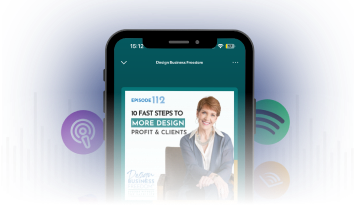10 Tips for an Efficient Design Business
Staying efficient while juggling multiple projects, clients, and daily tasks is essential for interior design success. Streamlining your operations, boosting productivity, deliver more profit and satisfaction in your work Here are ten tips (with fifteen more to come in the next post) to help you establish efficient interior design business operations and drive more profitability.
#1 Establish Realistic Goals
The foundation of any efficient business is setting realistic, achievable goals. At the end of each year—or right now, if you haven’t done this yet—take the time to map out your goals for the year ahead.
Detail your annual goals into quarterly, monthly, and weekly targets. This approach helps you tackle large tasks one step at a time, preventing overwhelm and ensuring steady progress in order to maintain efficient interior design business operations.
Tracking your progress is equally important. Set milestones along the way and celebrate each win, no matter how small. Celebrating your achievements keeps you motivated and reinforces a positive, forward-moving mindset. Remember, course corrections are easier when you’re regularly checking your progress.

#2 Streamline Your Communication
Email overload is a common source of inefficiency in design businesses. Minimize your email by unsubscribing from unnecessary lists using tools like Unroll.me and organizing your inbox with digital folders. Leveraging communication tools such as Slack, Google Chat, Basecamp, or Asana can help keep team communications organized and reduce the clutter in your inbox.
Another key tip is to establish a communication protocol in your client agreements. By setting boundaries on when and how clients can contact you, such as responding to emails and voicemails only twice a day, you protect your time and focus. Consider becoming a non-text firm for client communications, reserving texts for contractors and vendors only.
#3 Set Healthy Boundaries
Healthy boundaries are essential for maintaining your sanity and efficiency. Clearly define your work hours and stick to them. This includes turning off business notifications outside of your set hours so you’re not constantly bombarded by pings, dings, and other distracting notifications.
Make sure your boundaries are outlined in your client agreements and honor them. If you’ve communicated that you’ll respond to emails between 9 AM and 11 AM, and again from 3 PM to 5 PM, make sure you adhere to this schedule. Consistency builds trust and helps clients respect your time.
#4 Modernize Your Project Management
If you’re not using a design-driven project management software, you’re making your job harder than it needs to be. Explore tools like Design Manager, Studio Designer, MyDoma, Design Files, Programma, DesignSmart, and others to find the one that best suits your firm’s needs. These tools help you keep track of all project details, timelines, and communications in one place, streamlining your workflow and promoting efficient interior design business operations.
If you already use project management software but don’t love it, consider exploring other options. The right tool can make a significant difference in your efficiency and overall satisfaction with your work.
#5 Reduce Meetings
Meetings can be a huge time suck if not managed properly. Reduce the number of meetings you hold and make the ones you do have more efficient. Every meeting should have a clear agenda provided in advance, including to clients and contractors. Stand-up or walking meetings can help keep things brief and focused.
To further streamline meetings, use AI tools to record and transcribe discussions, allowing you to focus on the conversation rather than taking notes. Wrap up each meeting with clear action items and deadlines to ensure everyone knows what needs to be done and by when.
#6 Embrace Time Blocking
Time blocking is a powerful tool for managing your schedule and reducing overwhelm. Instead of reacting to tasks as they come up, plan your days and weeks in advance, allocating specific blocks of time for different activities. Use tools like Google Calendar to color-code tasks and create a clear visual map of your day.
Time blocking eliminates the chaos of last-minute decisions and helps you stay focused on what’s important. By organizing your time into dedicated blocks for specific tasks—such as creative design work, client meetings, business development, and self-care—you can ensure that everything gets done without feeling rushed or overwhelmed.
#7 Utilize Automation Tools
Automation tools can save you significant time by handling repetitive tasks like invoicing, scheduling, and follow-ups. Tools like Zapier, Dubsado, or HoneyBook can automate processes that would otherwise eat up valuable time. By setting up workflows that run on autopilot, you can focus on higher-level tasks that require your creativity and expertise.
Automating routine tasks not only increases efficiency but also reduces the chance of errors, ensuring that your business runs smoothly and professionally.
#8 Delegate and Outsource
Delegation is crucial for any growing business. Identify tasks that can be handled by someone else, whether it’s a team member or an outsourced professional. This could include administrative work, social media management, or even aspects of project management.
By delegating tasks that don’t require your direct input, you free up time to focus on what you do best—designing beautiful spaces. Remember, your time is valuable, and investing in help can lead to greater profitability and business growth.
#9 Implement Feedback Loops
Establishing feedback loops with both clients and team members is key to continuous improvement. Ask for feedback at specific milestones in each project to identify areas for growth and refinement. This proactive approach helps you refine your processes and deliver better results.
Regular feedback ensures that you’re meeting client expectations and allows you to make necessary adjustments before small issues become bigger problems.
#10 Celebrate Small Wins
It’s easy to get caught up in the hustle of running a business, but it’s important to celebrate the small wins along the way. Whether it’s completing a project on time, receiving positive client feedback, or hitting a revenue target, take time to acknowledge and celebrate these achievements.
Celebrating wins not only boosts morale but also reinforces the positive habits and processes that lead to success. It’s a simple but effective way to maintain motivation and keep your team engaged.
Key Takeaways
These ten tips are just the beginning of creating efficient interior design business operations. By setting realistic goals, streamlining communication, establishing healthy boundaries, modernizing project management, and reducing unnecessary meetings, you can free up time and energy to focus on what you do best—creating beautiful, functional spaces for your clients.
When you’re ready to increase your interior design business profits, work exclusively with ideal clients, and enjoy the time and resources for your extraordinary life, explore your coaching options. We’ve got your back in the business of design and the business of home. Stay tuned for Part 2, where you’ll get 15 more tips to help you further enhance your business efficiency.





